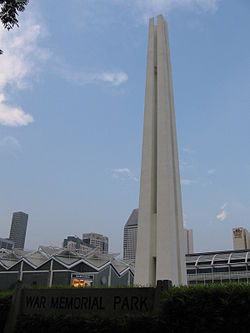- Civilian War Memorial
-
The Memorial to the Civilian Victims of the Japanese Occupation, usually called the Civilian War Memorial (Chinese: 日本占领时期死难人民纪念碑; Malay: Tugu Peringatan Bagi Mangsa Awam Pemerintahan Jepun) is one of Singapore's most famous iconic landmarks of heritage.
Built in memory of the civilians killed and massacred during the Japanese occupation of Singapore during World War II, the Civilian War Memorial sits on serene parkland in the midst of busy city traffic near Singapore's Padang and City Hall. Located within the War Memorial Park at Beach Road within the Central Area, Singapore's central business district, it is usually easy to spot in most backdrops encompassing the CBD landscape.
Contents
History
During the Japanese Empire's occupation of Singapore during the Pacific War (1942-1945), thousands of ethnic Chinese were killed in the Sook Ching massacre. In an effort to remove anti-Japanese elements in Singapore, Chinese men between the ages of 18 and 50 were to report to the Kempeitai, the Imperial Japanese Army military police. The death toll was reported to be 6,000 by the Japanese, but official estimates range between 25,000 and 50,000.[1]
In February 1962, remains belonging to civilian victims of the Japanese occupation were unearthed in areas like Siglap, Changi and Bukit Timah. The Singapore Chinese Chamber of Commerce and Industry (SCCC) undertook the responsibility of gathering the remains and creating a memorial.
On March 13, 1963, Prime Minister Lee Kuan Yew set aside a plot of land at Beach Road for the building of a memorial dedicated to the civilians killed in World War II. The SCCC set up a fund committee that was later enlarged to include all ethnic groups due to good response from the community. With the support of the government and contributions from the public, construction of the memorial was able to start.
Construction of the memorial began on April 23. 1966. The memorial was completed in January 1967, at a total construction cost of about S$500,000.
On February 15, 1967, the Civilian War Memorial was officially unveiled by then Prime Minister Lee Kuan Yew, who laid a wreath at the memorial. Every year on February 15 (Total Defence Day in Singapore, representing the 1942 surrender of Singapore to the Japanese), a memorial service is held at the Civilian War Memorial to remember the victims of the war.
Architecture
The design itself was conceived by one of Singapore's most renown architects, Leong Swee Lim (1935-2002) of Swan and Maclaren Architects, whose design subsequently won first prize in an open design competition. The design of the structure has been one of Swee Lim's most famous and significant contributions towards the legacy of Singapore's architectural history. The architect's conception of the four identical pillars each 70m high, represents the shared experiences and unity of the four major races of Singapore - Chinese, Malay, Indian and other races. Henceforth the memorial is essentially one of Singapore's iconic landmarks of heritage that truly embraces the virtues of a multi-racial and cultural city, whose unity is inevitably one of the pillars for Singapore's modern day success, harmony and prosperity.
The memorial has also been affectionately described by some as resembling four giant chopsticks. Unseen to the eye, the remains of the unidentified war victims are buried beneath the monument and truly adds to the material significance of the structure whose history it represents.
See also
- History of Singapore
- Battle of Singapore
- The Cenotaph, Singapore
- Kranji War Memorial
- Monument to the People's Heroes, a monument in Shanghai, China, with architectural similarities
Notes
- ^ Wong Heng (1997-09-29). "Operation Sook Ching". Singapore Infopedia, National Library Board. http://infopedia.nlb.gov.sg/articles/SIP_40_2005-01-24.html. Retrieved 2007-09-18.
References
- National Heritage Board (2002), Singapore's 100 Historic Places, Archipelago Press, ISBN 981-4068-23-3
- "The Civilian War Memorial". Ministry of Defence (Singapore). http://www.mindef.gov.sg/imindef/about_us/history/birth_of_saf/v05n04_history.html. Retrieved 2007-08-17.
External links
Categories:- Downtown Core (Singapore)
- Buildings and structures completed in 1967
- Landmarks in Singapore
- Monuments and memorials in Singapore
- World War II memorials and cemeteries
Wikimedia Foundation. 2010.

